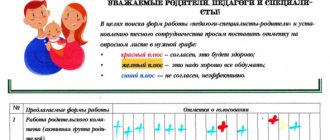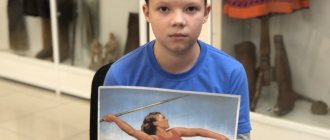Forms of physical education and health workconsultation on physical education on the topic
Forms of physical education and recreational work in preschool educational institutions.
Health is not only the absence of disease or physical defects, but also complete physical, mental and social well-being.
Russian Academy of Medical Sciences
One of the main tasks in a preschool institution is to protect and strengthen the health of children, comprehensive physical development and hardening of the body. In our kindergarten, a system of physical education and health work has been created, which contributes to the formation of a healthy, strong, seasoned, cheerful, responsive, proactive child, who has good control of his movements, loves sports and physical exercise, and is capable of learning at school and for active subsequent creative activities. For this purpose, all conditions have been created that meet the medical and educational requirements for preserving and strengthening the health of children. Kindergarten teachers use various forms of physical education and health work with children, taking into account their level of development and health status. Physical education in a preschool institution is carried out not only in educational activities in physical education, but also in everyday life. Several forms of physical education and recreational work are carried out every day throughout the day.
Morning exercises are one of the important components of the motor regime; its organization should be aimed at raising the emotional and muscle tone of children. Daily physical exercise promotes the manifestation of certain volitional efforts, developing a useful habit in children of starting the day with morning exercises.
Morning exercises should be carried out daily before breakfast for 6-12 minutes. outdoors or indoors (depending on environmental and weather conditions).
When compiling morning exercise complexes throughout the year, it is important to remember their variability in content and nature. Along with traditional morning exercises, different types and variants of it can be introduced into the practice of preschool institutions, both in terms of content and in methods of implementation. We offer different options. Morning gymnastics of a play nature includes 2-3 outdoor games or 5-7 play exercises of an imitation nature, as well as varying degrees of intensity, which are performed as a set of exercises with a general developmental effect. Exercises on an obstacle course - children can be offered exercises with a gradual increase in load: increasing the complexity of motor tasks with the inclusion of different basic types of movements, increasing the number of repetitions, increasing the tempo of movements, changing the alternation of physical training aids. Morning exercises can be carried out in the form of a health jog. This type of morning exercises must be carried out in the air - for 5-7 minutes. continuous running at an average pace with a gradual increase in distance and time. At the end of the gymnastics, breathing exercises are offered. A set of musical and rhythmic exercises (consisting of a warm-up, 5-6 basic developmental exercises in dance movements.)
The content of morning exercises includes various formations and formations, various types of walking, running, jumping with a gradual increase in the motor activity of children. Exercises for balance and coordination development, outdoor games and basic developmental exercises are offered.
The complex of morning exercises should be repeated for two weeks.
In older preschool age, children must independently reproduce the entire complex after 2-3 repetitions. During the organization, musical accompaniment is necessary.
Physical education is carried out by the teacher as needed (for 3-5 minutes) depending on the type and content of educational activity, mainly at the moment of signs of fatigue in children. Before the start of physical education, the transoms should be opened.
It is well known that physical education sessions are used to maintain mental performance at a good level. At the moment when children’s attention decreases and motor restlessness appears (usually for 12-15 minutes), fatigue sets in, you can offer several physical exercises while standing at their tables or in an empty seat in the group. These are general developmental exercises: bending the torso, moving the arms up and to the sides, half-squats and squats, bouncing, skipping, walking. A physical education session can be accompanied by text related or not related to the movement of the activity. When pronouncing a text by children, it is necessary to ensure that they exhale when pronouncing the words of one line, and take a deep and calm breath before the beginning of the next line. After physical education, the child’s breathing remains calm. You can conduct physical education with musical accompaniment, during which children can perform dance exercises or improvised movements.
Motor warm-up (dynamic pause) is carried out during a long break between classes, allowing you to actively relax after mental stress and forced posture. It consists of 3-4 exercises, as well as voluntary movements of children using a variety of physical education aids. At the end of the warm-up, it is rational to do a relaxation exercise for 1-2 minutes. Warm-up duration is no more than 10 minutes.
Outdoor games, physical exercises while walking. Outdoor games are complex motor, emotionally charged activities. Outdoor games serve as a method of improving motor skills already mastered by children and developing physical qualities. Outdoor games are divided by content into outdoor games with rules and sports games.
Awakening gymnastics. After a nap, it is important to improve the mood and muscle tone of each child, as well as take care of the prevention of posture and foot problems. This can be facilitated by a complex of gymnastics after daytime sleep, which is variable in nature, depending on this, its duration will also change (from 7-15 minutes).
A set of exercises is carried out in bed. Children gradually wake up to the sounds of melodic music, lying in bed, for 3-4 minutes, perform 4-5 general developmental exercises. You can offer exercises from various positions: lying on your side, on your stomach, sitting. After this, the children walk, gradually turning into running - they run out of the bedroom into a well-ventilated group with a temperature of 17-19 degrees, after which they move on to the massage paths. Children study in their underpants and barefoot. After carrying out various variants of gymnastics, they move on to water hardening procedures: wiping with a damp mitten followed by rubbing with a dry towel. In our preschool institution, much attention is paid to hardening procedures, which especially affect the promotion of health and the reduction of morbidity.
Hardening is the most important part of the physical education of preschool children. The best means of hardening are the natural forces of nature: air, sun and water. The purpose of hardening is to develop the body’s ability to quickly bring the functioning of organs and systems into line with the changing external environment. As a result of hardening, the child becomes less susceptible to sudden changes in temperature and colds and infectious diseases. Seasoned children have good health and appetite, are calm, balanced, cheerful, cheerful, and highly productive. Such results can be achieved only with the correct implementation of hardening procedures.
Positive results from hardening procedures can only be expected if such principles as gradualism, consistency, systematicity, complexity, taking into account the individual characteristics of each child are observed, as well as an active and positive attitude of children towards hardening procedures.
Air hardening is the most accessible means of hardening at any time of the year. Systematic exposure of a child to the air helps the body adapt more quickly to changing temperature conditions. The positive effects of air baths increase if combined with physical exercise.
In addition to organized physical education activities in the daily routine of children of senior preschool age, independent motor activity should occupy a significant place. However, here too, children’s actions largely depend on the conditions created by adults. With proper guidance of independent activities, you can significantly influence the variety of games and movements without suppressing the initiative of the child himself.
Independent motor activity of children is organized at different times of the day: in the morning before breakfast, between classes, during play hours after naps and during walks (morning and evening). Active actions of children should alternate with calmer activities. It is important to take into account the individual characteristics of each child and his well-being.
When planning independent activities, it is important to take care of creating a physical education and play environment (space sufficient for movement, variety and rotation of aids and toys), and allocate special time in the daily routine for children to play independently. To create diversity and novelty in the physical education and gaming environment, the teacher can introduce various physical education aids during the day and group them in different ways. This avoids monotony of movements and promotes the all-round development of children.
The teacher must influence the children’s choice of appropriate exercises and games, providing them with the necessary equipment, manuals, and explaining the methods of movement. It teaches children to play together, encourages more dexterous children who have good command of movements to help their peers.
Finger games are a very important part of developing fine motor skills. These games are very emotional and exciting. They promote the development of speech and creative activity. Finger games seem to reflect the reality of the surrounding world - objects, animals, people, their activities, natural phenomena. During finger games, children, repeating the movements of adults, activate hand motor skills. This develops dexterity, the ability to control one’s movements, and concentrate attention on one type of activity.
Finger games are the staging of any rhymed stories or fairy tales using the fingers. Many games require the participation of both hands, which allows children to navigate the concepts of “right”, “left”, “up”, “down”, etc.
Breathing exercises can be performed during morning exercises, exercises after waking up, or while walking.
At first, breathing exercises seem to be one of the most difficult for children. And it is all the more important to help children by turning boring exercises into a fun game.
You should not set a goal to complete all the exercises at once. You can perform several well-known ones, gradually supplementing them with new ones, or change them, dividing them by day of the week.
By teaching your preschooler simple and fun breathing exercises, you will make an invaluable contribution to his health + prevention of ARVI.
Eye gymnastics is used for preventive and health purposes to prevent visual fatigue in children. A set of eye gymnastics exercises is performed to music for 3-5 minutes. It includes up to 5 exercises, including massage exercises, rubbing, eye strain relief, and attention exercises. As you get used to the complex, new exercises are included in it or the conditions for performing previously learned exercises become more complicated.
Only by implementing an integrated approach can one achieve the fulfillment of the main objectives of educational work to strengthen the physical, mental and sexual health of children and their optimal physical development. Yu.F.Zmanovsky

